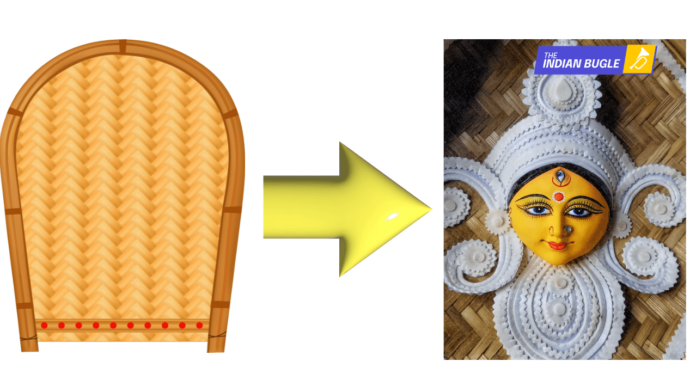Kulo art is the practice of painting and decorating the kulo, a shallow bamboo winnowing tray traditionally used in Bengal to separate grain from husk. Over the years, this everyday household tool has been reborn as a vibrant folk canvas. From goddesses and wedding scenes to bold floral borders and geometric designs, painted kulos are now cherished as wall hangings, ceremonial pieces, and festive decorations. Today, they occupy a special place during Durga Puja, when homes and pandals glow with these colourful circular artworks.
A Brief History
The kulo began as a tool of survival in agrarian Bengal. Made of woven bamboo or cane, it was an indispensable object in every rural household. As folk painters sought new surfaces beyond cloth and paper, the kulo emerged as a perfect circular frame for traditional motifs. By the early 20th century, painted kulos were already being used in weddings and local ceremonies. With time, they evolved from utility to art, gradually gaining recognition as a unique form of Bengal’s folk expression. Today, kulo art is not just tradition — it is also fashion, décor, and cultural identity.
The Art and Its Making
A painted kulo is a blend of natural craftsmanship and artistic imagination. The process usually involves:
- Base Preparation: A bamboo or cane kulo is primed with a base coat, often white, to ensure colours shine through.
- Painting: Acrylic paints are most common today, chosen for their brightness and durability. Artists often depict Durga, Lakshmi, Saraswati, wedding couples, folk dancers, or abstract designs.
- Finishing Touch: The tray is sealed with varnish or lacquer to protect it and give it a glossy finish.
Each kulo tells a story — whether through Jamini Roy-inspired simplicity, Kalighat-style brushwork, or modern experimental designs.
Symbolism in Culture
The kulo holds deep symbolic value in Bengal:
- Agrarian Roots: It represents grain, harvest, and sustenance — a connection to the land and community.
- Ritual Significance: Painted kulos are essential in Bengali weddings, used in rituals and as decorative items.
- Spiritual Canvas: Their circular form makes them ideal for painting deities, turning them into portable shrines that fit easily into homes and puja pandals.
Thus, the kulo bridges everyday life, spirituality, and celebration.
Why Kulo Art Shines During Durga Puja
Durga Puja, the grandest festival of Bengal, is a time when every corner is transformed with creativity. Kulo art becomes especially relevant during this period for several reasons:
- Perfect for Goddess Imagery: The round shape of the kulo suits compact depictions of Goddess Durga and her symbolic features, making it a natural canvas for festivals.
- Affordable Festive Décor: Lightweight and colourful, kulos are popular as pandal décor, home adornments, and festive souvenirs.
- Community Tradition: Just as clay idols from Kumartuli symbolize the larger puja economy, kulo painters also experience a surge in demand during the festival.
- Auspicious Symbol: As the kulo represents prosperity and abundance, it becomes an ideal accessory during the worship of Maa Durga, the goddess of power and fertility.
Modern Revival
In recent years, kulo art has moved from local craft fairs to global online marketplaces. Artists experiment with fusion designs — such as Madhubani on kulos, contemporary abstracts, and even personalized portraits. Urban homes use them as rustic wall décor, while NRIs buy them as cultural tokens. Weddings, too, increasingly feature customised kulos as gifts and decorative props. This modern revival has breathed new life into a tradition once limited to villages.
Challenges and Preservation
While hand-painted kulos are in demand, mass-produced and machine-printed versions often flood the markets, threatening the uniqueness of the art. Authentic kulo art relies on human skill, patience, and folk heritage. Supporting artisan groups, buying directly from craftspeople, and promoting handmade products are key to preserving this craft for future generations.
DIY Trend
Many art enthusiasts now try painting kulos at home. With a little creativity, anyone can turn a plain bamboo tray into a festival-ready decoration. A white base coat, acrylic paints, and a protective finish are all that’s needed to transform the humble kulo into a personalised piece of art. During pujas, these DIY kulos often become family projects, connecting generations through creativity.
Conclusion
Kulo art is more than decoration — it is the story of Bengal’s cultural resilience. From a farming household tool to a festive folk treasure, the kulo has travelled centuries carrying symbolism, devotion, and artistry. During Durga Puja, it becomes not just a canvas but also a bridge between tradition and modernity, rural roots and urban imagination. In every painted kulo, one sees the colours of Bengal’s heart and its ever-living devotion to the goddess.
